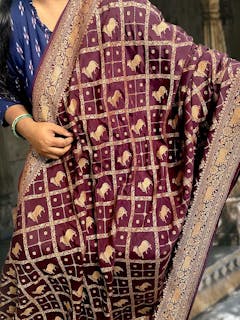Pichwai Sarees
Recently viewed
Exploring the Traditional Pichwai Divine Art on Handwoven Sarees
India is known for its rich cultural heritage and diverse art forms. One such traditional art form that has captivated art enthusiasts for centuries is Pichwai Divine Art. Originating from Rajasthan, Pichwai wall hangings and gold embellished Pichwai artwork depicts various scenes from Lord Krishna's life, primarily painted on cloth or canvas.
In recent times, Pichwai Divine art has found its way onto handwoven sarees, creating a beautiful fusion of art and fashion. This blog aims to delve into the mesmerizing world of Pichwai divine art on handwoven sarees, exploring its history, techniques, and significance.
The History of Pichwai Divine Art
Pichwai divine art traces its roots back to the town of Nathdwara in Rajasthan, where it emerged as a devotional art form in the 17th century. Originally created as temple hangings, Pichwai divine art was used to adorn the shrines of Lord Krishna. The word "Pichwai" translates to "something at the back" in the local Rajasthani language, referring to the paintings placed behind the deity. These intricate artworks were not just religiously significant but also served as a visual medium to narrate stories from Lord Krishna's life.
Themes and Motifs
Pichwai divine art often revolves around various themes related to Lord Krishna, particularly his childhood and Ras Leela. The artists use vibrant colors and intricate detailing to depict the various episodes from Krishna's life. Some common motifs found in Pichwai wall hangings and other art forms include peacocks, lotus flowers, cows, Radha-Krishna, gopis (cowherd girls), and other elements associated with Krishna's divine existence.
Techniques and Process
Creating a Pichwai divine art requires immense skill, patience, and attention to detail. The traditional technique involves a combination of painting, dyeing, and printing. The base fabric, usually cotton or silk, is first handwoven to create a saree. Then, the outline of the design is sketched using a brush or pencil. Next, natural dyes derived from minerals, plants, and other organic sources are used to fill in the colors. Gold and silver foils may also be added to enhance the richness of the artwork. The final step involves adding intricate details and embellishments to bring the painting to life.
Pichwai divine art on Handwoven Sarees
In recent years, Pichwai divine art has transcended its traditional canvas and found a new expression on handwoven sarees. This fusion of art and fashion has gained popularity among saree enthusiasts and art collectors alike. The intricate Pichwai motifs, carefully hand-painted on luxurious handwoven sarees, add a touch of elegance and traditional charm to the garment. These sarees become a canvas for artists to showcase their creativity, combining the timeless beauty of Pichwai art with the grace of a saree.
Significance and Preservation
Pichwai divine art holds immense religious and cultural significance in the Indian art landscape. They are not only revered as devotional art but also cherished for their artistic value. The preservation of this art form is crucial to keep the traditions alive for future generations. By incorporating Pichwai painting on handwoven sarees, artisans are ensuring that the art form reaches a wider audience, thereby promoting its appreciation and encouraging its continuation.
The fusion of Pichwai divine art with handwoven sarees creates a visual treat that celebrates the rich cultural heritage of India. The intricate artistry, vibrant colors, and traditional motifs of Pichwai paintings come alive.
Buy Pichwai Divine Art Handwoven Sarees at Chinaya Banaras
Chinaya Banaras has a wide range of handwoven sarees and dress materials with Pichwai divine art. Each handwoven saree, dress material, and suit sets are of high quality and make a worthy buy indeed. Chinaya Banaras is a one-stop solution for all your ethnic wear needs. Visit Chinaya Banaras to explore the entire range.



























